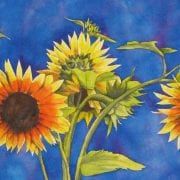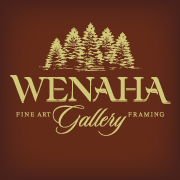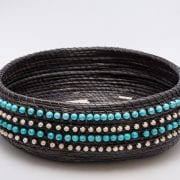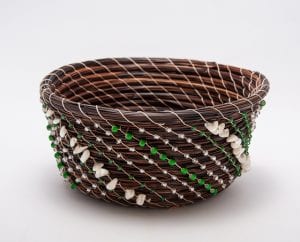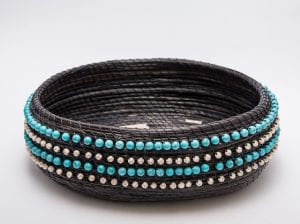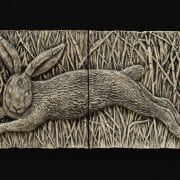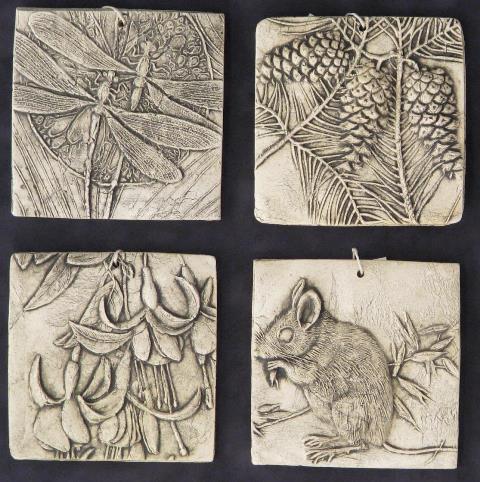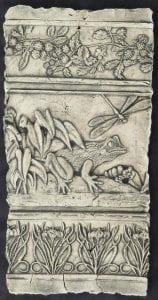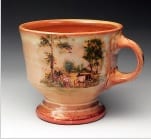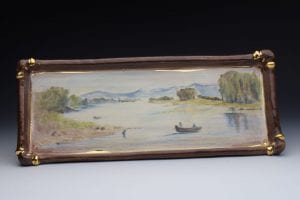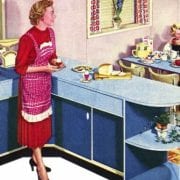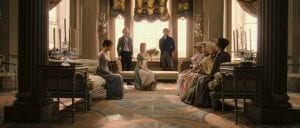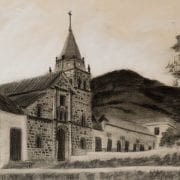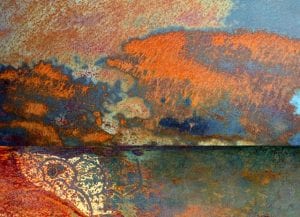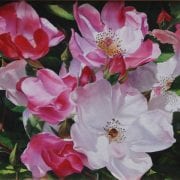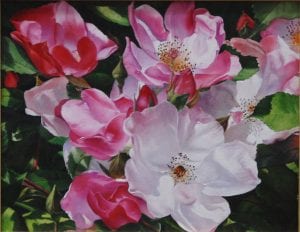Flowers — Bold, Bright Beautiful Watercolors by Maja Shaw
People who are not early risers get tired of this catching the worm thing, which, frankly, is literally for the birds. As watercolor painter Maja Shaw knows, there’s plenty of time to enjoy a leisurely cup of coffee and still get the perfect photo reference for her next painting.

Shasta Daisies, a close-up view of bold, impressionist watercolor flowers set against an abstract background, by Maja Shaw
“Conventional wisdom says photographs are better made in early morning, or late evening,” the Richland, WA, artist says. “But I’m not a morning person, so my reference photos are made in the middle of the day, which is bad for people shots, but great for flowers.”
Shaw, whose first name is pronounced Maya, as in the ancient Central American people, focuses on florals with bold, sculptural shapes and exuberant color. Inspired by a childhood spent with art-collector parents, Shaw explores ways of rendering images using negative space, as opposed to intricate detail, to define a form. The resultant paintings blend the best of both worlds: representational and abstract.
Flowers, Landscapes, and Brushwork
“Highlights and contrast are characteristic of many of my paintings,” Shaw says. “Two of my favorite painters are Andrew Wyeth and John Singer Sargent.
“If you look at their paintings, especially watercolors, their subjects are defined as much by what is not painted, as what is. I take some of my inspiration from them by trying to define forms with a few strokes which convey enough visual clues so that the viewer’s eye can fill in the rest.”
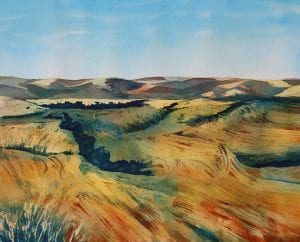
Palouse Harvest II, an impressionist landscape painting in watercolor by Richland artist Maja Shaw, guest artist at Wenaha Gallery
Shaw, who received her Bachelor of Fine Arts from the University of Washington, credits one of her art professors with providing a working definition of the category in which her artwork fits — organizational, as opposed to decorative or expressive.
“It’s a style that is concerned with shape, color, and composition and is not so concerned with making a philosophical statement, or, as my professor said, ‘What is the state of man in the world,'” Shaw explains.
People React to Color
“I don’t make social commentary with my art, and I’m not trying to make the viewer figure out any obscure meaning.
“I find people react emotionally to color and to subject matter: if my paintings are appealing to a viewer in either of these, then that is fine with me.”

Lily Family, white flowers against a deep blue background, impressionist watercolor by Richland artist Maja Shaw
In the spirit of being inspired by the masters, both old and new, Shaw also experiments with collage, in which she takes watercolor paintings with which she is not 100 percent satisfied, cuts them into shapes, and “repurposes” them into a new art form.
“I have taken inspiration for these from Henri Matisse and Eric Carle,” Shaw says, explaining that when 20th century French artist Matisse could no longer paint because of failing eyesight, he cut out shapes and had assistants paste them on large pieces of paper at his direction.
“They were mostly semi-abstract shapes, many with lots of white space around them, although many were reminiscent of plant shapes or body shapes.”
Regional and National Shows
One of Shaw’s early cut paper piece won third place in the Waterworks Art Center Show in Miles City, MT, for an exhibit with a paper theme.

Golden River, an impressionist interpretation of the Southeast Washington landscape, by watercolor painter Maja Shaw
“Mine are different from most collage work because I put them together to actually form a recognizable subject, rather than the mishmash of most collage artists.”
Over the last several years, Shaw has juried into major regional and national shows, and recently garnered First Place at the 311 Gallery Flowers and Garden Show in Raleigh, NC, where she won Honorable Mention last year. She has collected First, Second, and Third Place winnings at shows in Michigan, Colorado, Montana, and Washington, and has been the featured artist at the Crossroads Carnegie Art Center in Baker City, OR and the Cheryl Sallee Gallery in Auburn, WA.
Showcasing Eastern Washington
A member of CyberArt509, an artist’s cooperative encompassing artists in the 509 phone area code, and the Mid-Columbia Watercolor Society, Shaw shows her work throughout the Tri-Cities. In addition to painting flowers, which she describes as being good subjects because they don’t move around, except in the wind, and are as close as her backyard, Shaw also creates landscapes in the same spontaneous, colorful style.
“I strive to create recognizable images without being photographic,” Shaw says.
“While some compositions lend themselves to metaphors, mostly I want the viewer to enjoy the beauty of color and shapes based on the world around us.”
Maja Shaw is the featured Pacific Northwest artist at Wenaha Gallery from Monday, September 25 through Saturday, October 21, 2017. She will be at the gallery in person Saturday, October 7, from 11 a.m. to 4 p.m., during Wenaha Gallery’s Art Walk, part of the Dayton on Tour and Fall Festival Celebration. She will be joined by Dayton watercolor artist Jill Ingram; Walla Walla musician Roy Anderson; Winthrop basket weaver and singer Lauralee Northcott; and Walla Walla felt artist Linnea Keatts.
Contact the gallery, located at 219 East Main Street, Dayton, WA, by phone at 509.382.2124 or e-mail art@wenaha.com. Gallery hours are 9 a.m. to 6 p.m. from Monday through Saturday, and by appointment. Visit the Wenaha Gallery website online at www.wenaha.com.

